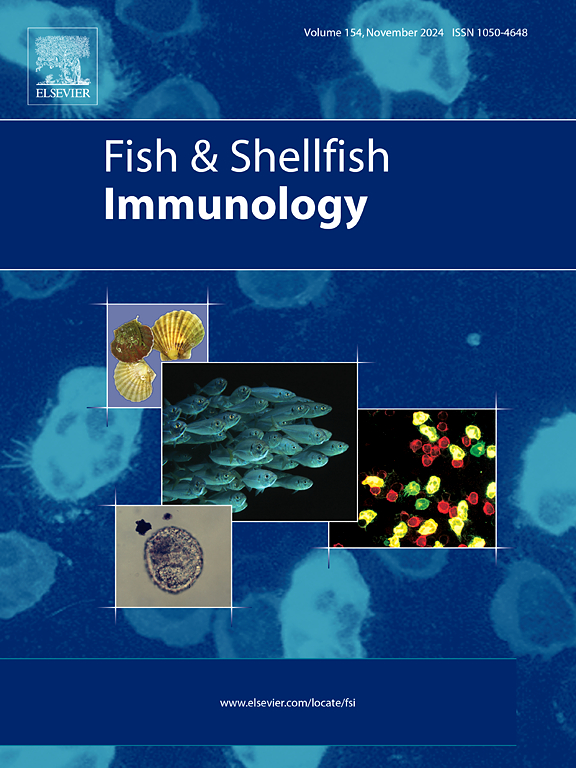Therapeutic effects of fumaric acid on proteomic expression and gut microbiota composition in Pacific white shrimp (Penaeus vannamei) infected with Ecytonucleospora hepatopenaei (EHP)
IF 4.1
2区 农林科学
Q1 FISHERIES
引用次数: 0
Abstract
Recently, microsporidiosis caused by a microsporidian [Ecytonucleospora (Enterocytozoon) hepatopenaei, EHP] has been found to seriously impact the global shrimp industry. The aim of this study was to evaluate the therapeutic effects of fumaric acid (FA) in EHP-infected Pacific white shrimp (Penaeus vannamei). In the first 2 groups, non-EHP-infected shrimp were fed FA-supplemented (10 g/kg diet) or normal feed (CM+ and CM-, respectively). The other 2 groups of EHP-infected shrimp were also fed FA-supplemented or normal feed (EM+ and EM-, respectively). All the experimental groups were fed for 7 days, and the hepatopancreas and intestine of the shrimp were sampled at 0, 1, 3 and 7 days after application (DAAs). The copy number of EHP in the hepatopancreas of the EM + shrimp was significantly lower than that in the hepatopancreas of the EM-shrimp at 3 and 7 DAAs (P < 0.01). Histopathological investigation revealed that the hepatopancreas of EM + shrimp began healing from microsporidiosis at 3 DAA and had almost completely recovered at 7 DAA. Proteomic analysis also revealed that the levels of immune-related proteins, such as β-1,3-glucan-binding proteins, the tumor suppressor TP53, and protein disulfide isomerase A3, were elevated in the hepatopancreas of the CM + shrimp compared with those in the control shrimp. Microbiome analyses from both LC‒MS/MS data and next-generation sequencing (NGS) of the shrimp intestine revealed that FA supplementation strongly affected the bacterial community in the shrimp gut. Based on the results from this study in the hepatopancreas of shrimp fed a diet of 10 g/kg FA for 7 days, FA strongly affected EHP proliferation; simultaneously, it increased the levels of several key molecules involved in oxidative stress, cellular stress and pattern recognition without harmful negative side effects; and effectively influenced the gut microbiota. This research is the first to show the effectiveness of FA in promoting shrimp health in the context of microsporidiosis in Pacific white shrimp and could be further applied in the global shrimp aquaculture industry.
富马酸对感染肝外核孢子菌(EHP)的凡纳滨对虾(Penaeus vanamei)蛋白质组学表达和肠道菌群组成的影响
近年来,一种由微孢子虫(Ecytonucleospora (Enterocytozoon) hepatopenaei, EHP)引起的微孢子虫病被发现,严重影响了全球虾类产业。本研究旨在评价富马酸(FA)对ehp感染的凡纳滨对虾(Penaeus vannamei)的治疗效果。前2组未感染ehp的对虾分别饲喂添加fa (10 g/kg日粮)和正常饲料(CM+和CM-)。另外2组ehp感染对虾也分别饲喂添加fa或正常饲料(EM+和EM-)。各试验组均饲喂7 d,分别于饲喂后0、1、3、7 d取肝胰脏和肠道标本。3、7 daa时,EM +对虾肝胰脏EHP拷贝数显著低于EM-对虾肝胰脏(P < 0.05)
本文章由计算机程序翻译,如有差异,请以英文原文为准。
求助全文
约1分钟内获得全文
求助全文
来源期刊

Fish & shellfish immunology
农林科学-海洋与淡水生物学
CiteScore
7.50
自引率
19.10%
发文量
750
审稿时长
68 days
期刊介绍:
Fish and Shellfish Immunology rapidly publishes high-quality, peer-refereed contributions in the expanding fields of fish and shellfish immunology. It presents studies on the basic mechanisms of both the specific and non-specific defense systems, the cells, tissues, and humoral factors involved, their dependence on environmental and intrinsic factors, response to pathogens, response to vaccination, and applied studies on the development of specific vaccines for use in the aquaculture industry.
 求助内容:
求助内容: 应助结果提醒方式:
应助结果提醒方式:


